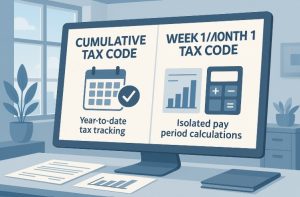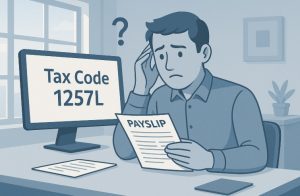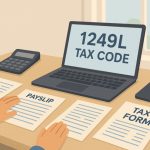Last Updated on: 24th July 2025, 11:00 am
Have you recently spotted the tax code 1257L cumulative on your payslip and wondered what it means? You’re not alone. This tax code is one of the most commonly used by HM Revenue and Customs (HMRC), but its implications can often feel confusing, especially if you’re new to employment or returning after a break.
Understanding your tax code helps you know whether you’re paying the right amount of tax throughout the year. The 1257L tax code includes a personal allowance, which is the amount of income you can earn before tax kicks in.
When it’s labelled as cumulative, it means HMRC is tracking your total income and tax payments over the whole tax year, not just one month or week at a time.
This blog breaks down everything you need to know about the 1257L cumulative tax code, how it works, what it means for your payslip, and what you should do if something looks wrong.
What Does the 1257L Cumulative Tax Code Mean?

The 1257L cumulative tax code is the most commonly used tax code in the UK for the 2025/26 tax year. It reflects your entitlement to the standard £12,570 Personal Allowance, which is the amount you can earn annually without paying income tax.
The number 1257 in the code corresponds to that allowance (1257 × 10), while the letter ‘L’ confirms eligibility for the full amount.
When the code is labelled “cumulative,” it means your income tax is calculated by tracking your earnings and tax paid from the start of the financial year, rather than just on a pay-period basis. This helps HMRC balance out any earlier overpayments or underpayments throughout the year.
You’re usually given this code if:
- You have one main job
- You have no untaxed income or taxable benefits
This system ensures you’re taxed fairly across the full year, not just from month to month.
How Does the 1257L Cumulative Tax Code Work on Your Payslip?
When applied to your payslip, the 1257L cumulative tax code ensures your tax-free income is spread evenly throughout the tax year. It directs your employer to deduct tax only after applying the correct amount of Personal Allowance to date.
Depending on how often you’re paid, your allowance is divided accordingly:
| Pay Frequency | Tax-Free Allowance |
|---|---|
| Monthly | £1,048.33 |
| Weekly | £242.50 |
The remaining income after applying the allowance is then taxed based on national income tax bands:
| Tax Band | Range | Rate |
|---|---|---|
| Basic Rate | £12,571–£50,270 | 20% |
| Higher Rate | £50,271–£125,140 | 40% |
| Additional Rate | Over £125,140 | 45% |
On your payslip, you’ll see your tax code listed, total tax paid to date, and your remaining allowance. If any figures seem off, especially in early pay periods, you could be due a rebate or a correction later in the year.
How Is 1257L Calculated Based on the Personal Allowance?

The 1257L tax code is calculated based on your Personal Allowance, which is the amount of money you can earn before income tax is deducted. For the tax year 2025 to 2026, the Personal Allowance remains at £12,570, as set by the UK government.
What is the Personal Tax-free Allowance for 2025?
Your personal allowance for the year is £12,570. This figure hasn’t changed from the previous year.
It’s applied as:
- £1,048 per month if paid monthly
- £242 per week if paid weekly
That means for every month or week, the same portion of your tax-free income is considered before calculating tax deductions.
How Does HMRC Apply Tax Cumulatively Through PAYE?
Under the Pay As You Earn (PAYE) system, HMRC expects your employer to apply your tax code to calculate how much tax to deduct based on your cumulative earnings.
Here’s how it works:
- At the start of the tax year (6 April), your employer assumes you’ll receive the same earnings throughout the year.
- Your tax-free allowance is split across each pay period.
- If you start work later in the year, your unused allowance from previous months is carried forward and factored into future calculations.
- This system automatically corrects overpayments or underpayments made in earlier periods.
For example:
If you begin work in July and haven’t used your allowance since April, you’ll receive a higher allowance in the following months to balance things out.
This also means:
- If you leave a job mid-year or have a career break, your total income and tax are still assessed over the year.
- You’re less likely to pay too much tax if your employer uses the correct code and updates it in time with HMRC.
The cumulative approach is generally fairer than non-cumulative methods, as it takes your full financial picture into account over the course of the tax year.
What’s the Difference Between Cumulative and Week 1/Month 1 Tax Codes?

The cumulative tax code, like 1257L, adjusts your tax based on your total income since the start of the tax year. In contrast, Week 1 or Month 1 codes calculate your tax based only on the current pay period.
Cumulative codes:
- Take into account all income earned from the start of the tax year.
- Provide a running total of tax paid and allowances used.
- Adjust automatically if you’ve over- or underpaid in earlier months.
Week 1/Month 1 codes:
- Ignore previous earnings or tax paid.
- Treat each payslip as if it’s the first one of the year.
- Often used temporarily when HMRC lacks full employment records.
If you see 1257L W1 or 1257L M1 on your payslip, it means you’re on an emergency tax code.
This might happen if:
- You started a new job, and your employer hasn’t received your P45.
- HMRC is awaiting confirmation of your full income history.
Being on a W1 or M1 code can cause you to overpay tax temporarily, but it’s usually corrected once HMRC updates your record.
Why Might Your Tax Code Change from 1257L?
Your tax code can change from 1257L for several reasons, and it’s usually HMRC’s way of adjusting your tax to reflect changes in your income or situation.
Common reasons include:
- You start receiving taxable benefits (like a company car).
- You have a second job or pension that affects your total income.
- You have underpaid tax in a previous year, and HMRC wants to reclaim it gradually.
- You become eligible or ineligible for Marriage Allowance, affecting the letter at the end of your code.
- You move between countries within the UK, such as from England to Scotland, which applies a different tax code prefix, like S1257L.
When your tax code changes, HMRC will usually notify both you and your employer. Your updated tax code should appear on your next payslip. If you disagree with the change or believe it’s incorrect, it’s important to contact HMRC as soon as possible to correct it.
How Can You Check or Correct Your 1257L Cumulative Tax Code?
Keeping an eye on your tax code helps you avoid overpaying or underpaying tax. You can check or update your tax code directly through HMRC.
Here’s how to verify your tax code:
- Check your payslip. Your tax code will be listed clearly.
- Sign in to your Personal Tax Account on the HMRC website.
- Use the HMRC tax code checker tool to see if your code is correct.
- Review the earnings and tax paid year-to-date to ensure they align with your actual income.
To correct your tax code:
- Contact HMRC online or by phone.
- Provide your National Insurance number and recent payslips.
- Explain any employment changes, benefits received, or previous overpayments.
HMRC will then issue a P6 notice to your employer, who will update your tax code on the payroll system. Any overpaid tax will usually be refunded through your salary, while underpaid tax may be spread over the remaining months of the tax year.
What Are Common Misunderstandings About the 1257L Tax Code?

The 1257L tax code is often misunderstood, even though it’s the standard one used by millions of UK employees. Several myths and misconceptions can cause confusion.
Here are a few common misunderstandings:
- 1257L means I won’t pay any tax: This is incorrect. It only means you have a tax-free allowance of £12,570 per year. Income beyond this is taxable.
- Cumulative means I’ll be taxed more: Actually, it’s often the opposite. The cumulative system helps smooth out tax payments and make up for over- or underpayments.
- If my tax code changes, I’ve done something wrong: Tax codes change for many administrative reasons and don’t necessarily indicate any error on your part.
- Week 1 codes are better because I pay less: W1 or M1 codes may feel like you pay less initially, but they don’t consider your full earnings and often result in tax corrections later.
By understanding how the code works and what it represents, you can better interpret your payslip and stay informed about your tax obligations.
What Should You Do If You’re On the Wrong Tax Code?
If you suspect you’re on the wrong tax code, it’s crucial to take action quickly to prevent overpayment or underpayment.
Steps to follow:
- Check your payslip or P60 for your current tax code.
- Log into HMRC’s online portal and review your income records.
- Compare your earnings against your tax-free allowance.
- Contact HMRC directly by phone or via your Personal Tax Account if anything looks incorrect.
You should especially act if:
- You’ve recently changed jobs.
- You’ve taken a career break or returned to work mid-year.
- Your payslip shows 1257L W1 or M1 for more than one month.
HMRC will typically adjust your code and issue a notice (P6) to your employer. Any excess tax paid may be refunded through payroll in a future pay period or by cheque at the end of the tax year. Quick action ensures you aren’t unfairly taxed and don’t end the year with a nasty surprise.
Conclusion
Understanding the 1257L cumulative tax code gives you more control over your finances and peace of mind about how much tax you’re actually paying.
It ensures your tax deductions are fair, balanced, and adjusted over time, especially helpful if your employment circumstances change during the year.
By regularly checking your payslip, knowing what to look for, and understanding how your allowance is spread, you can quickly spot errors and avoid under- or overpaying HMRC. If your code ever seems wrong or unclear, it’s always worth verifying it with HMRC early on.
FAQs
What does the L mean in the 1257L tax code?
The L in the 1257L tax code indicates that you are entitled to the standard personal allowance. This is the amount you can earn each year before income tax is deducted.
Is 1257L a good tax code?
Yes, 1257L is generally the best tax code for most employees. It means you’re receiving the full personal allowance and there are no unusual tax adjustments or deductions being made.
Can I claim back overpaid tax under the 1257L code?
Yes, if you’ve overpaid tax under the 1257L cumulative code, it’s usually corrected automatically. You may also request a refund through your HMRC personal tax account or at the end of the tax year.
How do I know if my 1257L tax code is cumulative?
Check your payslip, if it says 1257L CUM, then it’s cumulative. If it says 1257L W1 or 1257L M1, you’re on an emergency non-cumulative tax code.
Does the 1257L code apply in Scotland or Wales?
In Scotland and Wales, similar codes are used but with different prefixes. For example, in Scotland it may be S1257L, and in Wales C1270L, reflecting regional tax banding differences.
What should I do if my tax code is wrong?
Contact HMRC immediately. You can update your records through your personal tax account or call HMRC directly. Be ready to provide your National Insurance number and recent payslips.
Will my tax code stay the same every year?
Not necessarily. HMRC may adjust your tax code yearly based on changes in your personal allowance, income, benefits, or deductions. Employers typically receive updates before the start of a new tax year.




















No Comments
Leave a comment Cancel